Chilean Bellflower, also known as Lapageria rosea or Copihue, is a stunning vine native to Chile. This beautiful plant is the national flower of Chile and can add a touch of exotic elegance to your garden with its large, trumpet-shaped flowers in shades of red, pink, or white.
To successfully grow the Chilean Bellflower, it should be placed in partial shade, kept consistently moist, and shielded from strong winds. It prefers slightly acidic, well-draining soil, which can be enhanced by adding organic compost or peat moss.
Caring for Chilean Bellflowers requires attention but is rewarding. These vines can reach up to 30 feet in length and width, suitable for walls or trellises. With proper care, they produce leathery leaves and bell-shaped flowers from mid-summer to autumn.
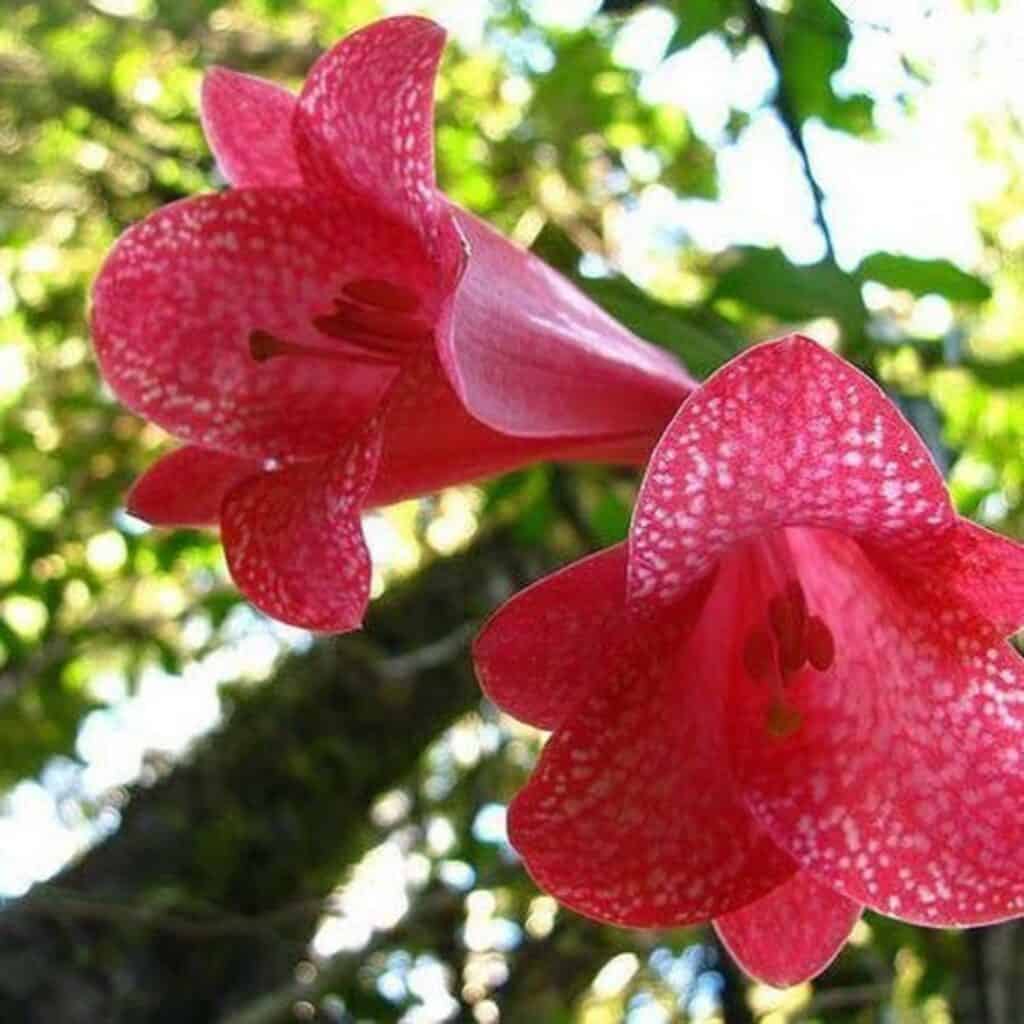

Botanical Profile and Origins
The Chilean Bellflower, or Lapageria rosea, is a stunning evergreen vine native to South America. It has a rich botanical history and grows naturally in specific regions of Chile and Argentina.
Taxonomy of Lapageria Rosea
The Lapageria rosea is the only species in the genus Lapageria, belonging to the Philesiaceae family. It was named after Empress Joséphine de Beauharnais, Napoleon Bonaparte’s first wife.
This unique vine is closely related to the Philesia magellanica, another flowering plant found in South America. Over the years, botanists have debated its classification, occasionally placing it in the Liliaceae family.
Natural Habitat and Geographic Distribution
You can find Lapageria rosea growing wild in the temperate rainforests of central and southern Chile and in parts of western Argentina, often climbing up trees or along forest edges..
The plant thrives in cool, moist environments with partial shade and prefers well-drained, acidic soils rich in organic matter.
In its native habitat, Lapageria rosea can grow up to 32 feet tall and is adapted to survive in areas with mild winters and cool summers. The plant’s natural range extends from about 35° to 45° south latitude.
Hummingbirds play a key role in pollinating wild Lapageria rosea plants and other animals. They help spread the plants’ seeds, allowing the species to maintain its population in the wild.
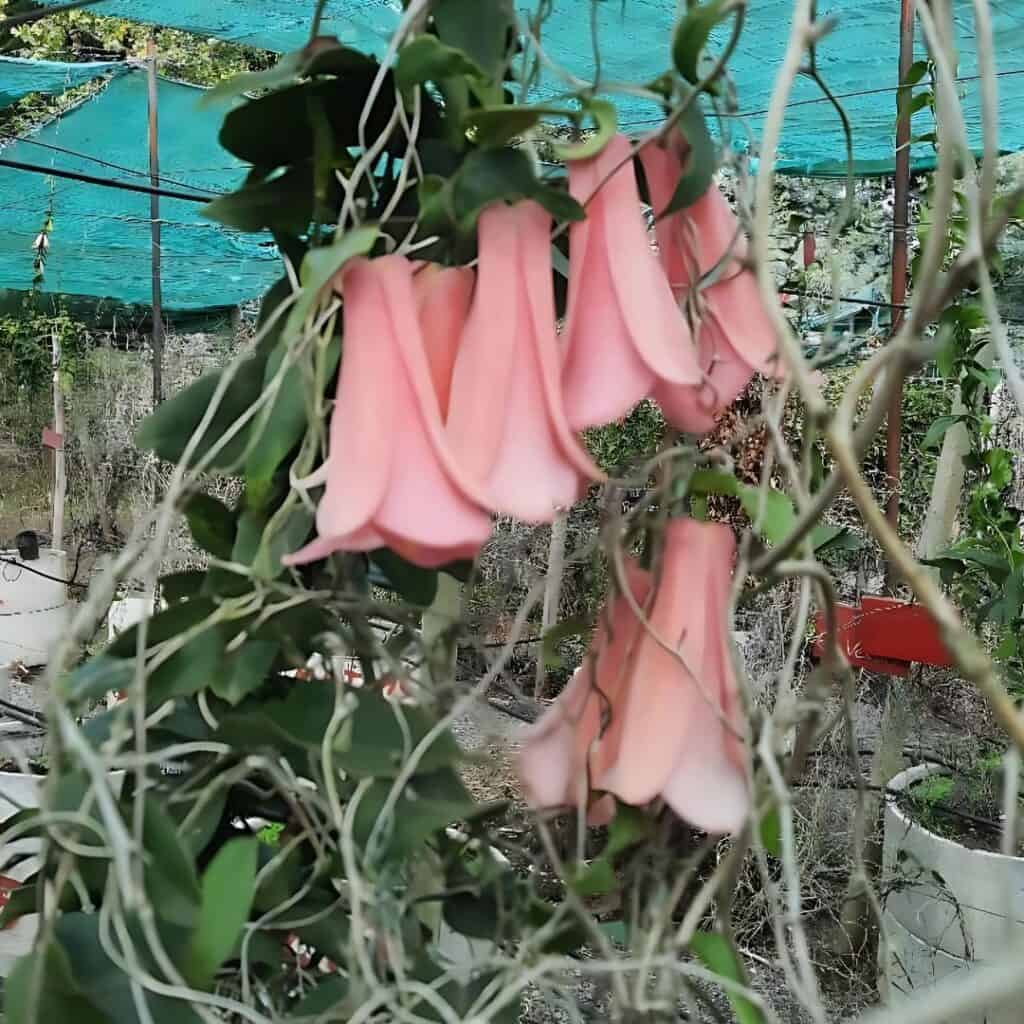

Planting Techniques and Cultivation
Chilean Bellflower needs specific conditions to thrive. Proper planting and care will help your vine grow strong and bloom beautifully.
Soil Preferences
Chilean Bellflower likes acidic soil with good drainage. Aim for a pH between 5.5 and 6.5. For the right texture, mix peat moss, pine bark, and perlite.
Use a ratio of:
- 2 parts peat moss
- 1 part pine bark
- 1 part perlite
This mix gives the roots air and holds moisture without getting soggy.
Add some slow-release fertilizer to the soil before planting. This feeds your vine as it grows.
Planting Procedures
- Start with a young plant or a cutting. Dig a hole twice as wide as the root ball and just as deep.
- Place the plant in the hole. The top of the root ball should be level with the soil surface.
- Fill in around the roots with your soil mix. Press gently to remove air pockets.
- Water deeply right after planting. This helps settle the soil and gives the roots a good start.
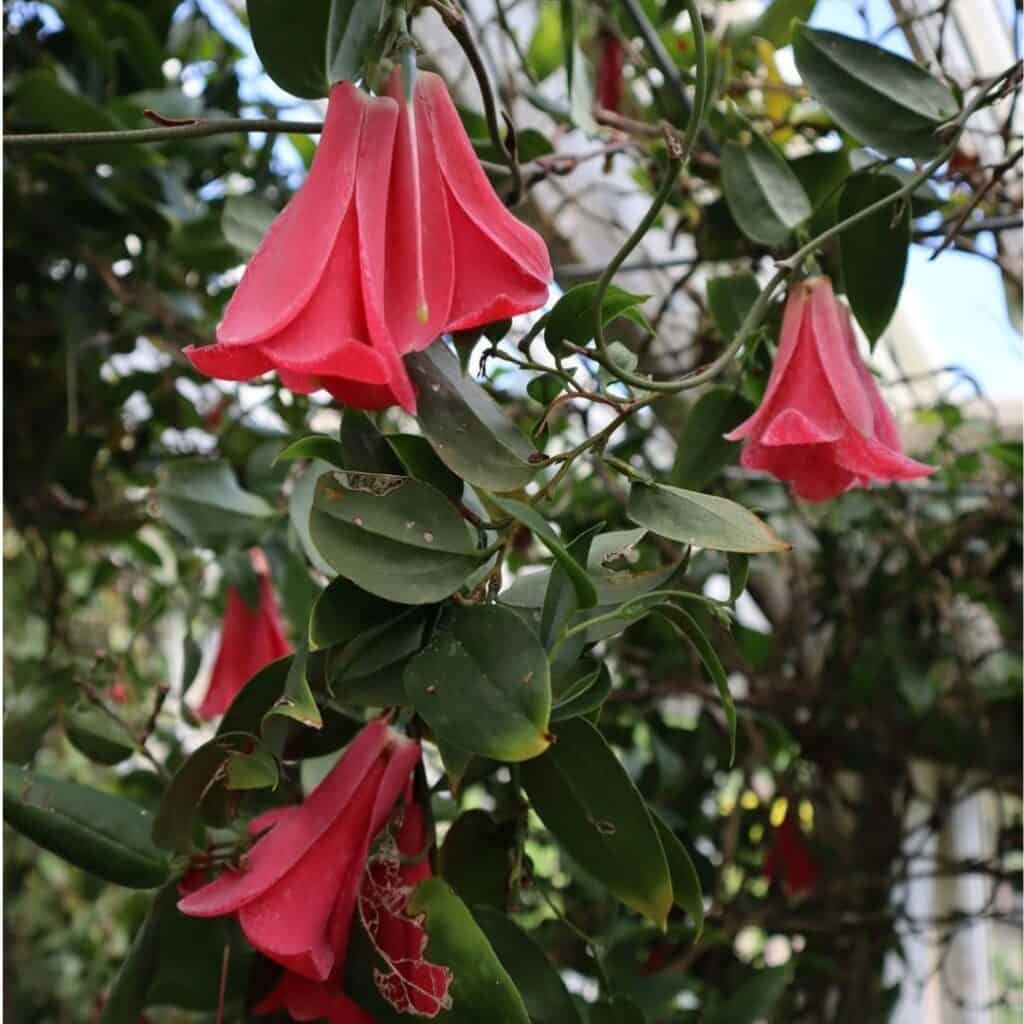

Optimal Planting Locations
- Chilean Bellflower likes partial shade. Find a spot with morning sun and afternoon shade.
- A north-facing wall works well, giving shelter and the right light.
- Make sure the area has good airflow. This helps prevent fungal problems.
- Avoid windy spots. Strong winds can damage the delicate vines and flowers.
Repotting and Transplanting
- Repot young plants every spring. Move to a pot one size larger each time.
- For mature plants, repot every 2-3 years or when roots fill the pot.
- Use a pot with drainage holes. This prevents water from pooling at the bottom.
- When transplanting, be gentle with the roots. They’re fragile and don’t like being disturbed.
- After repotting, water well. To help it adjust, keep the plant in a shady spot for a few days.
Care and Maintenance
The Chilean Bellflower thrives with specific care, including proper watering, light, and support. It’s also important to feed it regularly and make seasonal adjustments for optimal growth.
Watering Needs
The Chilean Bellflower needs moist but not waterlogged soil. Water the plant when the top inch of soil feels dry to the touch, which might require watering twice a week during summer.
To prevent fungal problems, always use room-temperature water and avoid wetting the leaves. A drip irrigation system is ideal for this plant.
When winter arrives, reduce the frequency of watering to ensure the soil doesn’t completely dry out.
Light, Temperature, and Humidity Requirements
The Chilean Bellflower flourishes best when grown in partial shade, as it needs to be shielded from the harsh afternoon sun. It thrives under morning sun or in areas that get dappled shade.
Ideal temperatures for this plant are cool, ranging between 55°F and 75°F (13°C and 24°C). It isn’t suited to extreme heat or cold conditions.
To keep the plant healthy, maintaining high humidity is key. You can mist the leaves every day, use a pebble tray with water, or in dry climates, a humidifier might be necessary to provide the needed moisture.
Pruning and Support
- The Chilean Bellflower vine needs support to grow properly. Use a trellis, fence, or sturdy stakes.
- Prune in late winter or early spring before new growth starts. Remove dead or weak stems. Trim back long shoots to encourage bushiness.
- Be gentle when handling the vine. The stems can be brittle and break easily.
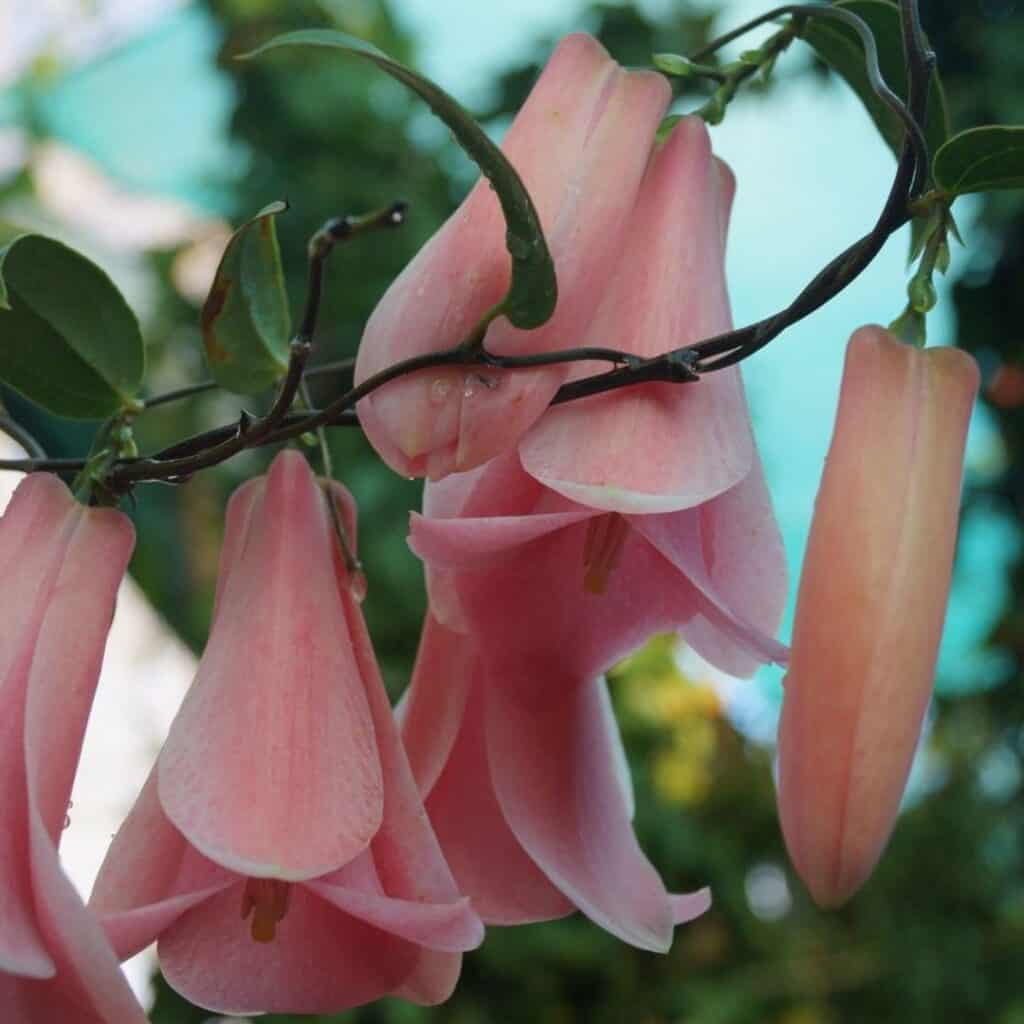

Feeding and Fertilization
During the growing season, fertilize your Chilean Bellflower every two weeks using a balanced, water-soluble fertilizer at half the recommended strength.
In the spring, enrich the soil with a slow-release fertilizer to ensure a consistent supply of nutrients all season long. Then, stop fertilization in late fall and winter as the plant’s growth declines.
Seasonal Care
During spring, it’s important to inspect your plants for any damage that may have occurred over the winter.
Prune as necessary to remove dead or damaged parts. As new growth starts, make sure to increase your watering routine to support your plants’ needs.
Summer is the most crucial growing period for your plants. During this time, keep your plants well-watered and regularly apply fertilizer to promote healthy growth.
Additionally, be on the lookout for pests such as aphids or spider mites, which can be more prevalent in the warmer months.
In the fall, you should start to decrease your watering frequency and stop fertilizing. This is also the time to think about moving any potted plants indoors if you live in an area prone to cold winters. This can help protect them from the colder temperatures and frost.
Winter care for your plants will vary depending on the climate in which you live. In milder regions, your plants might need little to no extra care during the winter months.
However, in colder areas, it’s critical to ensure your plants are protected from frost, which may involve additional insulation or moving plants to a sheltered location.
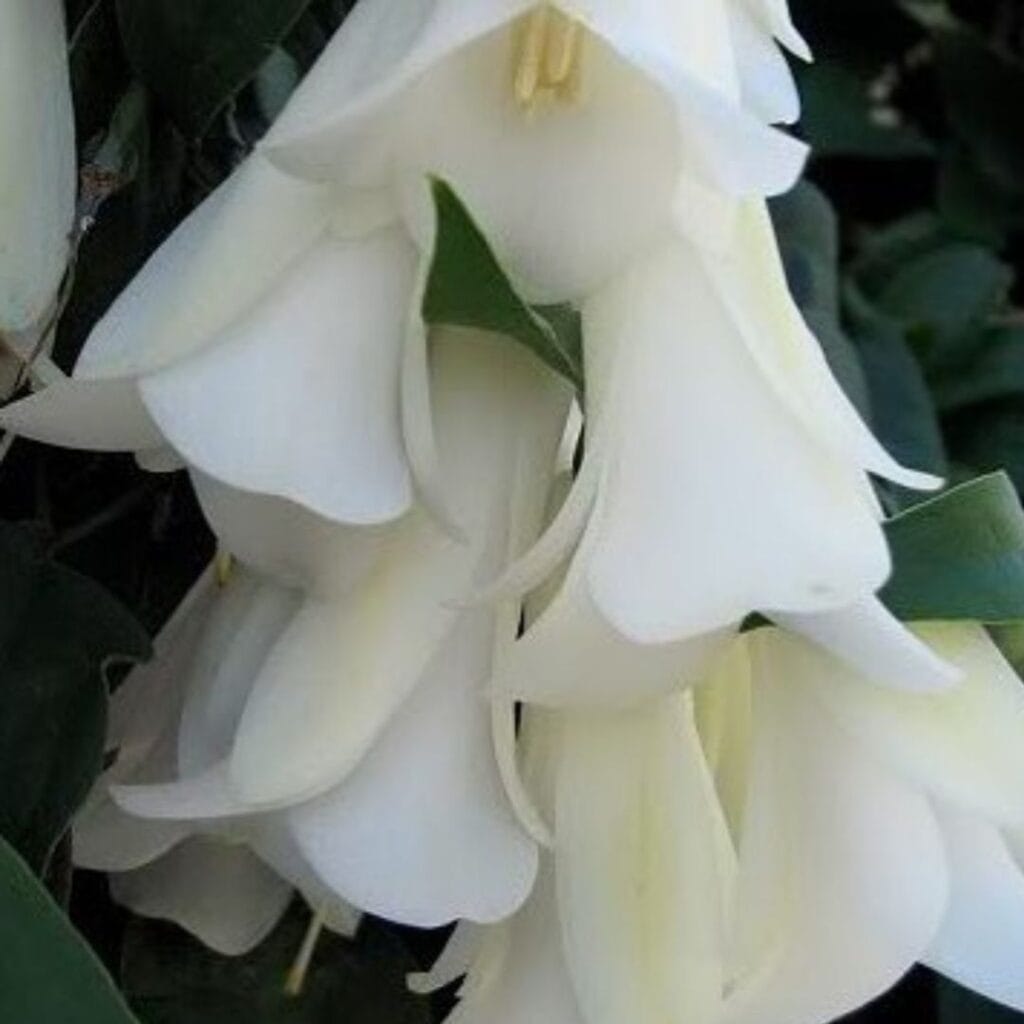

Propagation and Growth Habits
Chilean Bellflower, or Lapageria rosea, can be propagated in several ways. Let’s look at how to grow and care for this plant.
Methods of Propagation
You can grow Chilean Bellflower from seeds or cuttings. Seeds take a long time to grow. They should be planted in pots with acidic soil and lightly covered with soil or sand.
Stem cuttings are a faster method. In the spring, take 6-inch cuttings, remove the lower leaves, dip them in rooting hormone, and plant them in a mix of peat and sand.
Layering is also an effective method. Bend a low stem to the ground and cover part of it with soil. Over time, it will develop roots.
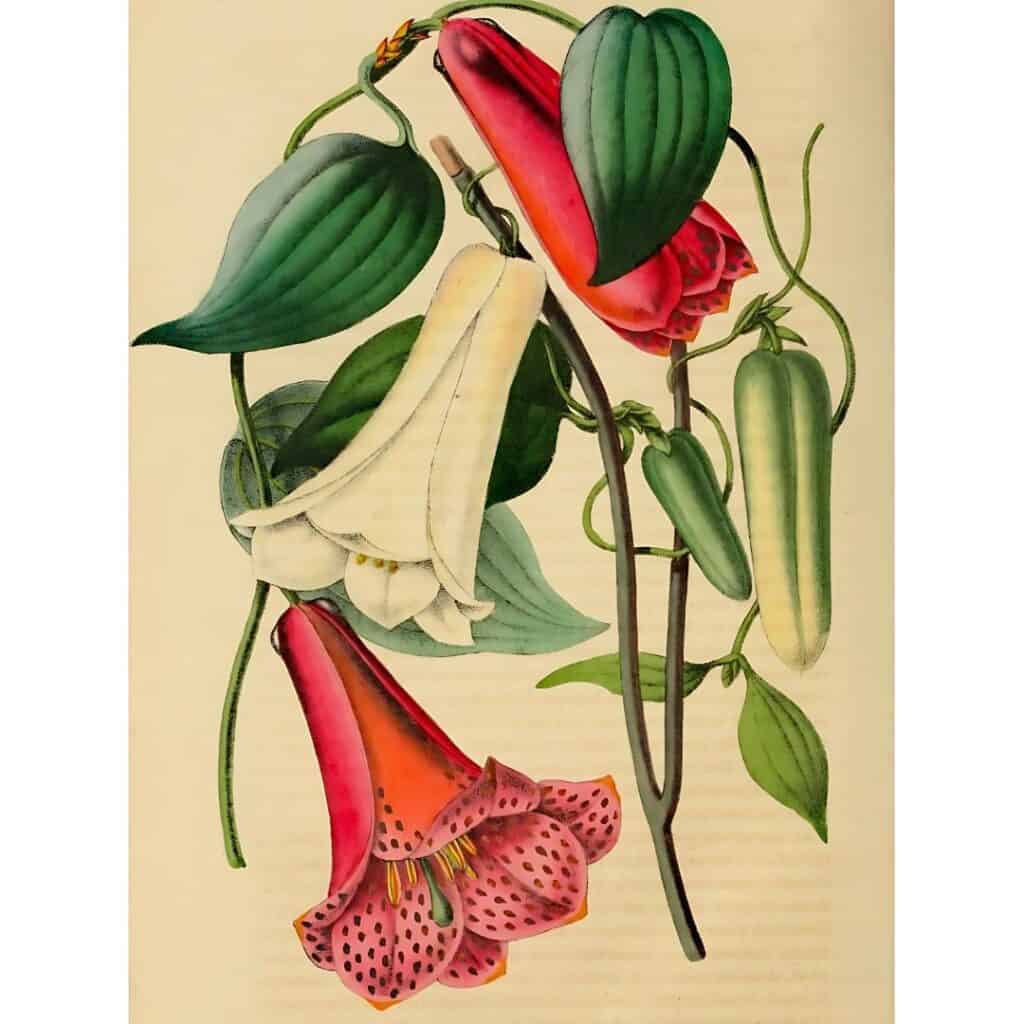

Understanding Growth Patterns
- Chilean Bellflower is a vine that can grow over 30′ feet tall.
- It spreads just as wide. The plant grows slowly at first.
- It needs support to climb. Give it a trellis or wire frame.
- The leaves are thick and leathery. The new growth is reddish and turns green later.
- Flowers bloom from summer to fall. They hang down like bells.
- Colors range from red to pink, sometimes with white spots.
Transplanting and Repotting Tips
Move your Chilean Bellflower carefully. It doesn’t like root disturbance. Transplant in spring before new growth starts.
- Choose a pot 2″ inches larger than the current one.
- Use a mix of peat, sand, and loam.
- Make sure the pot has good drainage.
- Water well after repotting.
- Keep the plant in shade for a week. This helps it recover from any transplant shock in move.
- Don’t fertilize right after transplanting. Wait a month to let roots settle. Then feed with a balanced, liquid fertilizer.
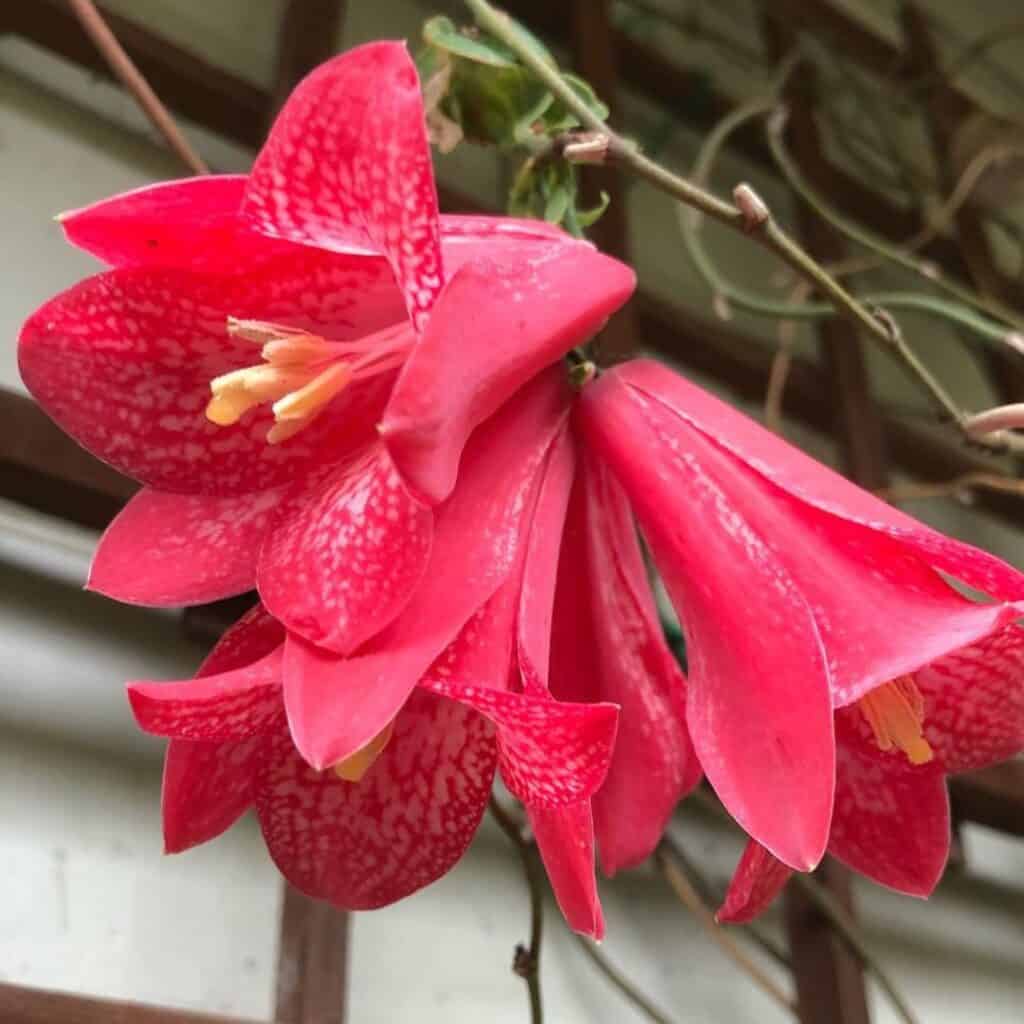

Common Challenges Growing Chilean Bellflowers
Growing Chilean Bellflowers can be tricky. You may face issues with pests, diseases, and climate stress. Here are some key problems to watch out for and how to deal with them.
Pests and Diseases
Chilean Bellflowers can attract unwanted bugs. Aphids and mealybugs are common pests. They suck sap from the plant, making it weak.
To fight these pests:
Fungal diseases can also be a problem. Watch for spots on leaves or stems. Keep the plant dry to prevent fungus. If you see signs of disease, cut off bad parts and use a fungicide.
Climate-related Stress Factors
- Chilean Bellflowers are picky about their climate. They don’t like it too hot or too cold.
- Frost can damage or kill the plant. If you live in a cold area, grow them in pots and bring them inside when it’s cold.
- Too much direct sun can burn the leaves. Place your plant in bright, filtered light for the best growth.
- Strong winds can harm the vines. Plant them near a wall or fence for protection.
- In hot weather, your plant might need extra water. But don’t let the soil get soggy.
- Good drainage is key to keeping your Chilean Bellflower happy and healthy.
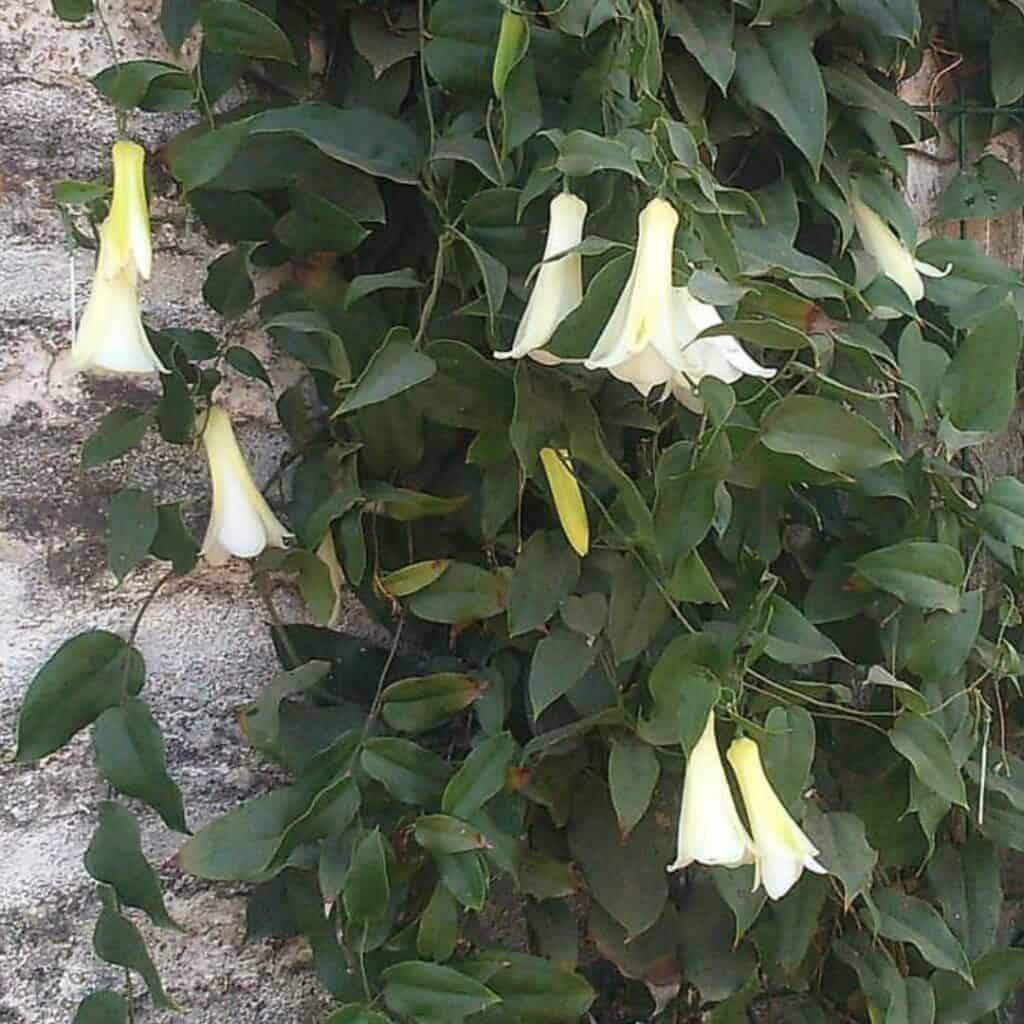

Enhancing Your Garden with Lapageria rosea
Companion Planting
Split text up into at most two sentences per paragraph.
Choose plants that like similar growing conditions to pair with Lapageria rosea. Ferns make great companions, as they enjoy the same shady, moist areas.
Plant hostas nearby for contrasting leaf textures.
Avoid plants that need full sun or dry soil. Good companions include:
- Astilbe
- Bleeding heart
- Japanese forest grass
These plants won’t compete for nutrients and will create a lush, woodland-like setting.
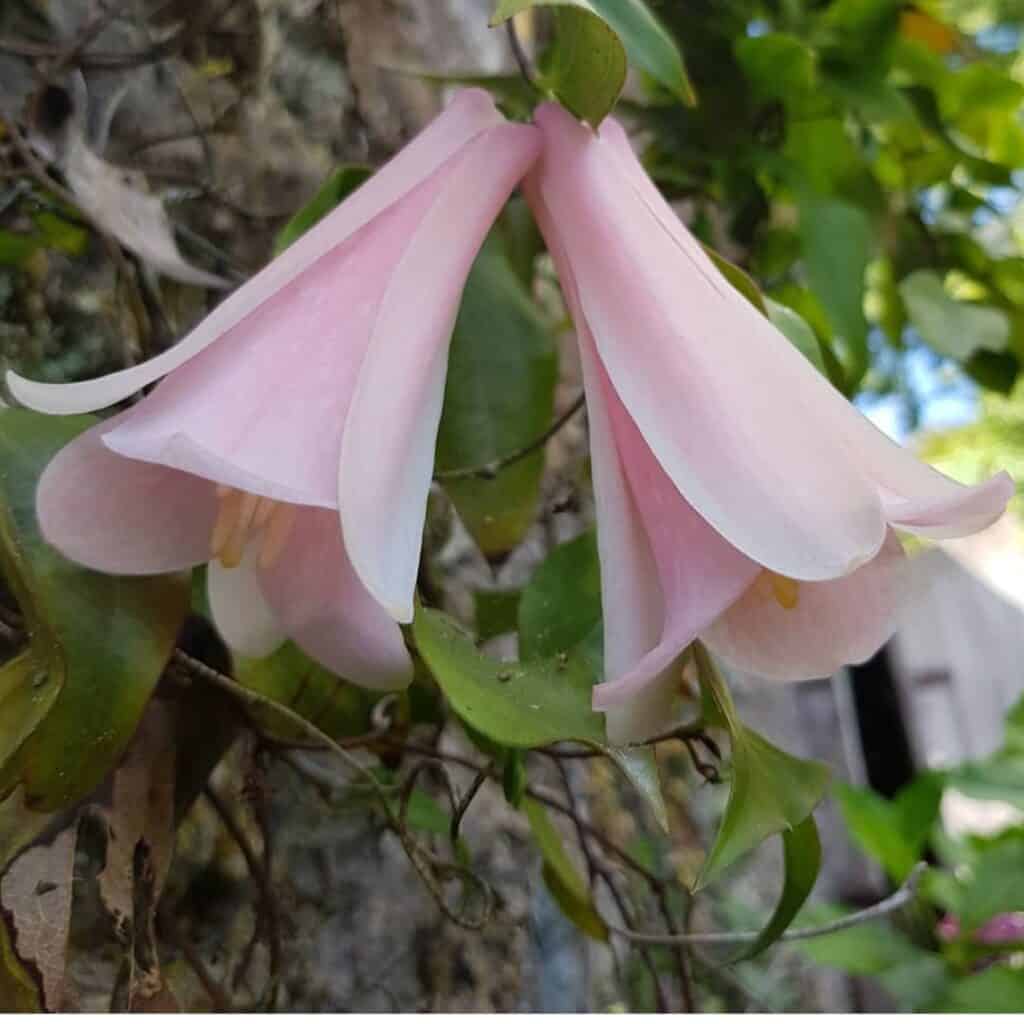

Landscape Uses
Lapageria rosea shines as a climbing vine in shaded areas. Train it up trellises, arbors, or walls for vertical interest.
It works well in:
- Woodland gardens
- Shaded patios
- North-facing walls
Use it to cover unsightly structures or create living screens. The vine’s thick foliage provides privacy when fully grown.
In colder climates, plant it near buildings for protection from frost and strong winds.
Filtered light is ideal, so avoid spots with direct sun.
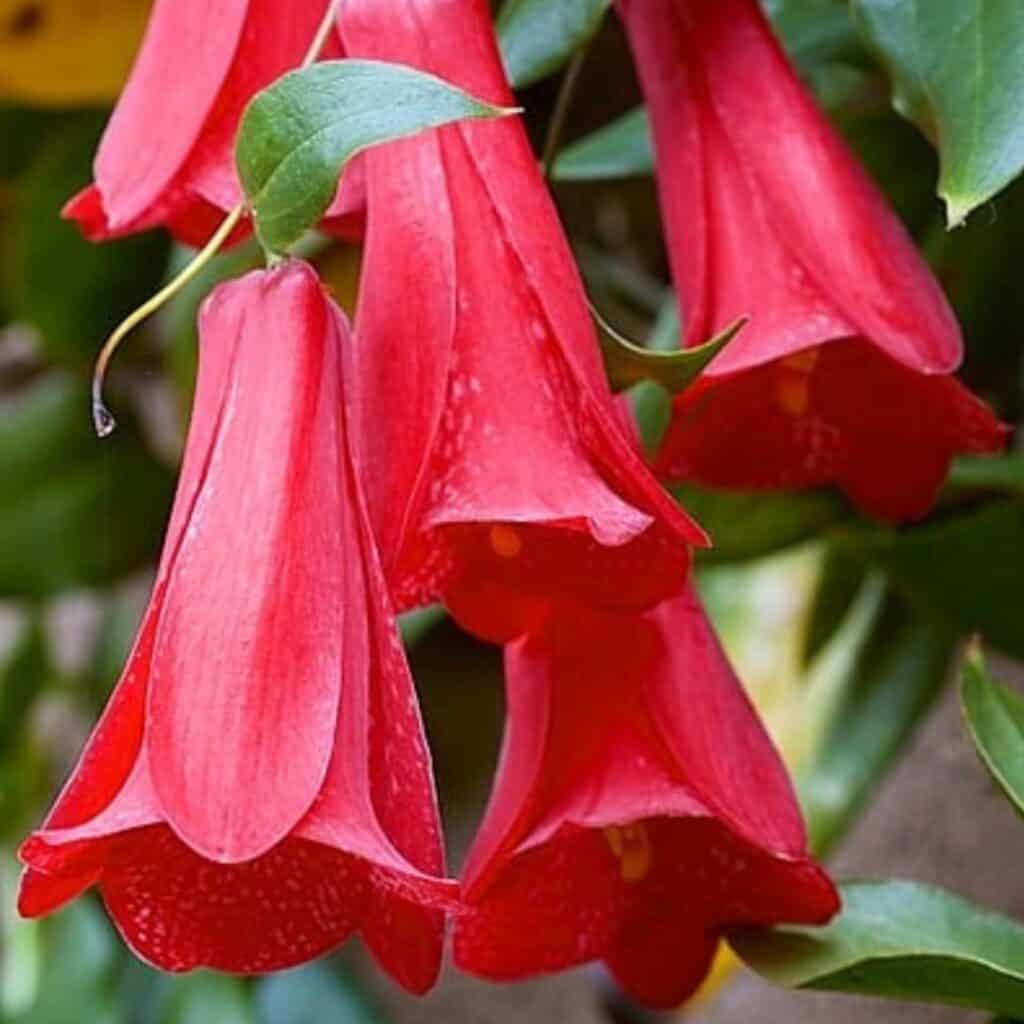

Container Growing
You can grow Lapageria rosea in containers, making it suitable for small spaces or areas with poor soil.
Choose a large pot at least 18 inches deep with good drainage holes.
Use a mix of:
- 2 parts potting soil
- 1 part perlite
- 1 part peat moss
This mix provides the acidic, well-draining soil the plant prefers.
Place the container in a spot with bright, indirect light.
Water regularly to keep the soil moist but not waterlogged.
Mist the leaves to increase humidity and deter pests.
Move containers indoors when temperatures drop below 20°F (-6.7°C) to protect from hard frost.
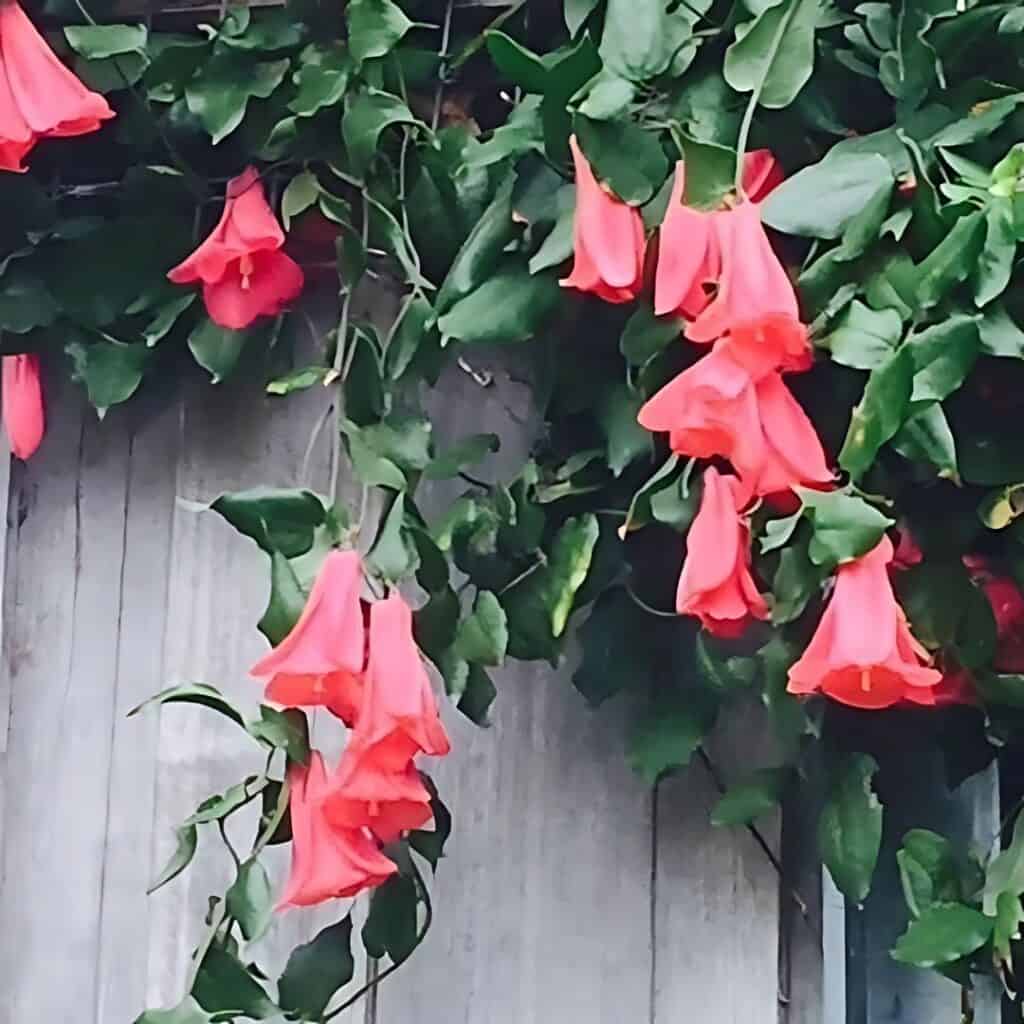

Final Thoughts
The Chilean Bellflower is a stunning vine with unique trumpet-shaped flowers. Its beauty makes it a prized addition to any garden.
You’ll find growing Chilean Bellflower rewarding but challenging. It needs specific conditions to thrive.
Remember these key care points:
- Plant in partial shade
- Keep soil moist but well-drained
- Protect from strong winds
- Provide support for climbing
With proper care, your Chilean Bellflower can reach impressive heights. Its long-lasting blooms will bring color to your garden for months.
Be patient with this slow-growing plant. The results are worth the wait.
By meeting its needs, you’ll enjoy the elegant Chilean national flower year after year. Your efforts will be rewarded with a truly spectacular display.




